Ambient Acoustics MAD16 IEMs – Crazy Music Colors
Ambient Acoustics MAD16 is an in-ear monitor priced at 2500 USD, designed with 16 balanced armature drivers, under the Main Audio Destination naming scheme. Given the price point, they have to be compared to other flagship IEMs, including CTM Clear Tune Monitors Da Vinci IX (1800 USD), Unique Melody MEST MK2 IEMs (1500 USD), Lime Ears Aether R (1400 USD), Final Audio A8000 (2400 USD), Audeze Euclid (1300 USD), and Fir Audio VxV (999 USD).

Introduction
Ambient Acoustics is one of the greatest titanic companies from Ukraine, a country that’s home to some of the best audio engineers and designers out there. Even the Romanian company Meze gets their drivers for the Empyrean from Ukraine, from Rinanro Acoustics, basically sourcing the most important component of their killer headphones there. Back to Ambient Acoustics, they are known for making summit-fi level custom monitors for singers, artists, as well as hearing protection aids. The company took shape in 2009, and since then they’ve been making both hearing aids and professional audio products, and they had success in the past as well with a series of IEMS under the LAM naming. We know that they make reliable IEMs, as no one ever complained about one of their IEMs breaking. Unfortunately, due to the current tragic situation in Ukraine, the company had to pause the production of those IEMs, but you can always contact them and make a preorder, as they aren’t out of business, and for the time being have reverted back to the professional, hearing aid and hearing protection segments, producing ingenious products to keep their people safe.
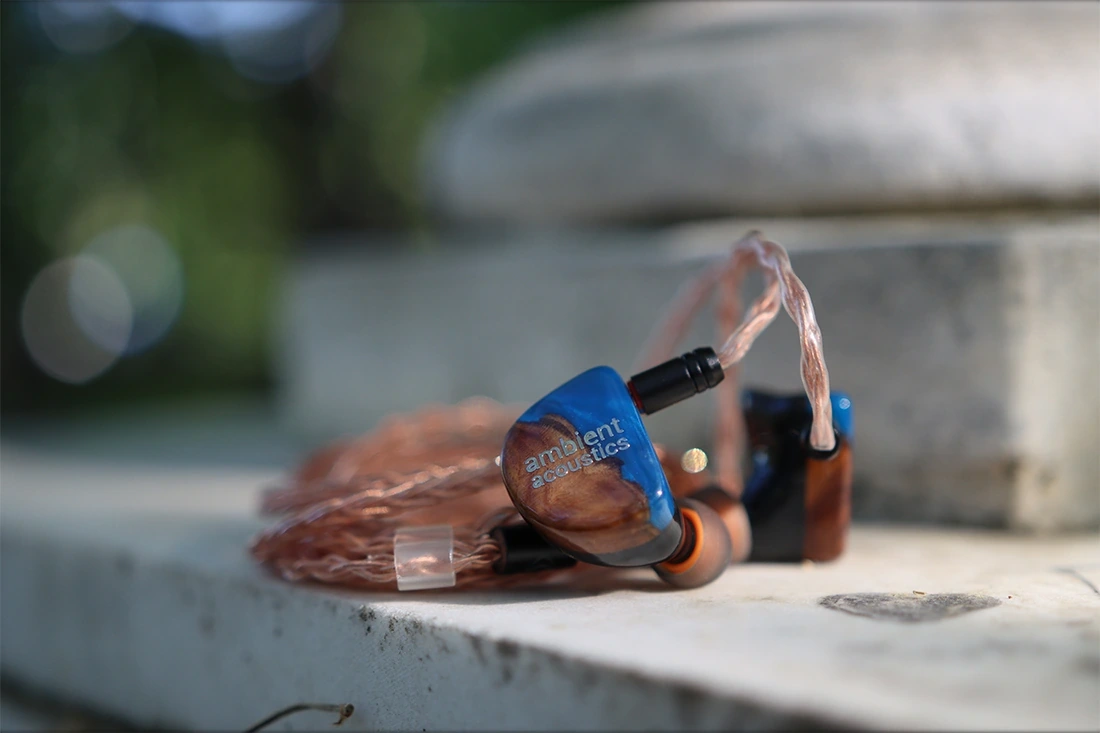
It should be noted that I have absolutely no affiliation with Ambient Acoustics, I am not receiving any incentive for this review or to sweeten things out. I’d like to thank Ambient Acoustics for providing the sample for this review. Every opinion expressed is mine and I stand by it. The purpose of this review is to help those interested in Ambient Acoustics’ Main Audio Destination MAD16 IEMs find their next music companion.
Product Link
You can grab one from www.amazon.com here: https://amzn.to/3ArX7R5
If you’re in the UK, you can grab one from www.amazon.co.uk here: https://amzn.to/3ArRrXg
And if you’re from Europe, you can grab one from www.amazon.de here: https://amzn.to/3PzyHJw
Build Quality/Aesthetics/Fit/Comfort
Starting with the design, MAD16 follows a similar design concept as MAD24, but the physical body of the IEM is smaller, as it needs far less space to accommodate the 16 drivers instead of 24, a reduction of about 33%. This can be felt in the physical comfort while wearing MAD16 too, as it is much more comfortable and easier to wear. On a happy note though, you won’t care about this if you go for the custom version of MAD16 and MAD24 as both are molded for your ears and will be plenty comfortable.
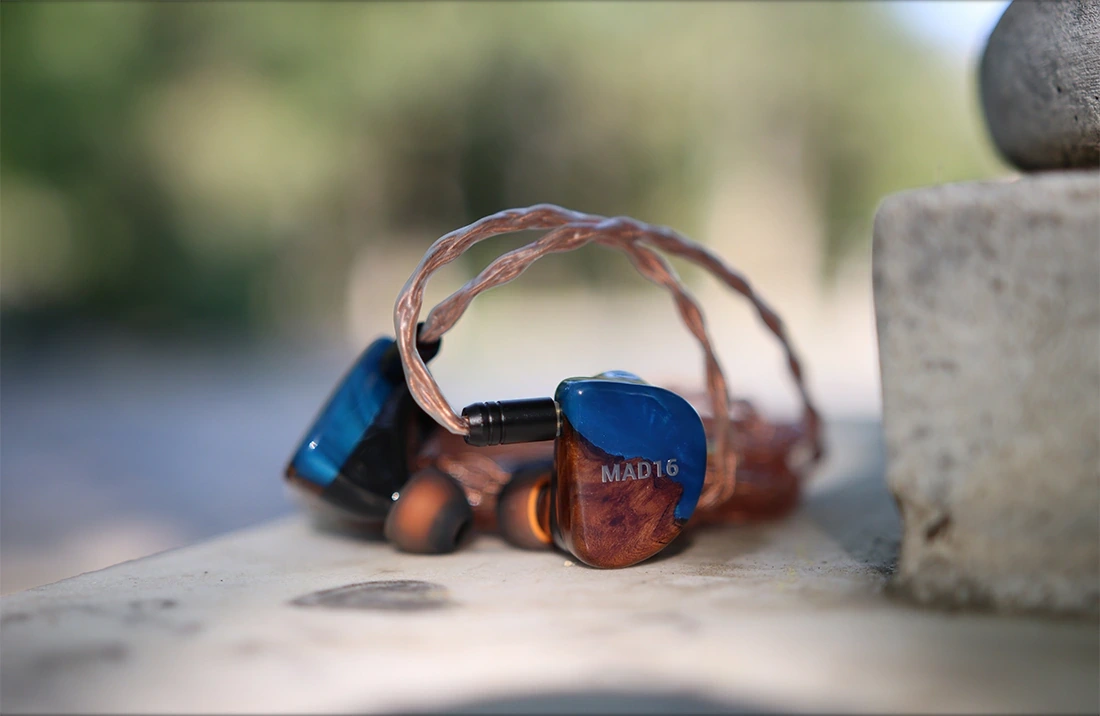
The cable of MAD16 is basically the same as the cable of MAD24, a high-end cable with copper wiring, 2-Pin connectors, and a non-tangle, non-microphonic design, as any high-end IEM should have. The outer shell of MAD16 is considerably more colorful than that of MAD24, but this is just a concept that Ambient Acoustics have created, and you can fully configure yours with anything, from skulls to anime girls to your favorite band logo. MAD16 also has a resin body that’s super nice for the skin, and the tips included with it are the same as those included with MAD24, a black-orange tip that’s good for comfort.
Like in their MAD24 IEMs, MAD16 comes with a complex set of low pass filters and tubes, and they’re 3D printed for the best sonic performance possible. Although there is no crossover implied in the design, MAD16 has perfect left-right channel balance and the drivers are all in perfect sync. A big part of why it is so hard to design an IEM with many drivers comes from the fact that if just one driver goes out of sync, music will start to sound audibly bad, and the more drivers, the harder it is to match them as well as Ambient Acoustics manage to.
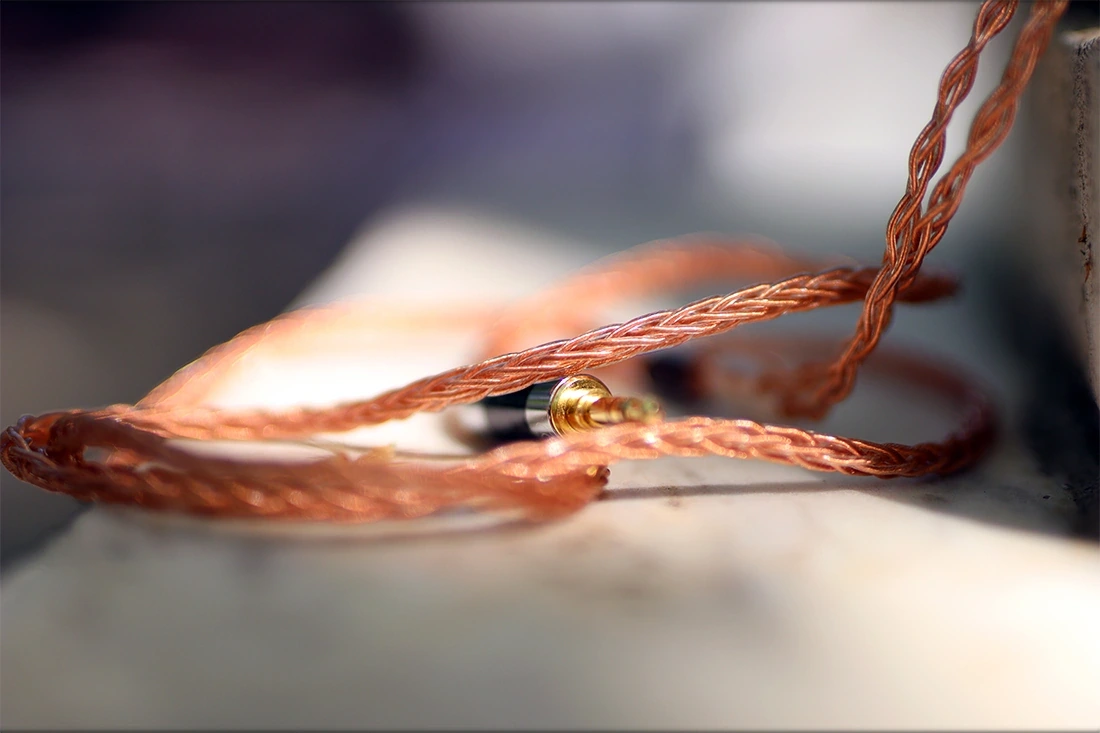
MAD16 uses the ANOR or Acoustic Notch Resonator, and SOER or Sound Occlusion Effect Reduction, MAD16 inherits all of the strengths that Ambient Acoustics have been able to develop through years of research. There can be no driver flex in an all-Ba IEM like MAD16, and happily there’s no strong void effect when inserting it, although there is a slight void when you do this. The passive noise isolation is extremely high, as high as 20-30 dB depending on the frequency you’re looking at. What’s more, MAD16’s custom version will have even higher passive noise isolation.
The way the drivers in MAD16 are arranged is 4 drivers for the InfraLow and Low end of the sound, 8 drivers for the midrange, and 4 drivers for the high / ultra high frequencies. With a quoted sensitivity of 118.6 dB, MAD16 is theoretically extremely easy to drive, but the package has a quoted impedance of 2.5 OHMs, one of the lowest I’ve seen in the wild. Despite this, there’s no strong hissing effect on MAD16, and it reacts like most IEMs with an impedance of 16 OHMs would, leading me to think that they actually have an impedance of around 25 OHMs, the 2.5 OHMs being a writing mistake. The design has no crossovers, which means that all drivers push the maximum loudness and volume they can, the matching being done when picking the drivers and designing the IEM rather than afterwards. This approach has some advantages, because there’s one less component that can fail (the crossover), but it makes the IEMS more expensive and harder to design in the early phases.

At the subjective level, MAD16 is still quite large, and at the limit for my ears. They are a comfortable and ergonomic pair of IEMs, but if you could go for the Custom version, that’s going to have all the advantages of MAD16’s sonics, but no disadvantages. The cable has no microphonic noise, and it is comfortable to use, plus detachable, so you can always go for a better aftermarket option.
Sound Quality
We need to start with the sources used to drive Ambient Acoustics MAD16, and those including iBasso DX320, Astell & Kern SE180, Astell & Kern SP2000T, Lotoo PAW6000, Dethonray DTR1+ Prelude, Tempotec V1A Variations, iBasso DX160, and Shanling M3X. All of those provide an excellent sonic experience with MAD16, all of them being able to easily drive MAD16. I can happily say that there’s no strong background hissing or background noise with MAD16, but they are more sensitive than most IEMs I have around, in line with Campfire Atlas. I also tried using a few dongle DACs and desktop sources, including iBasso DC06, Aune X1s GT, ddHIFI TC44C, and all of them have been able to drive MAD16 rather well. Better sources will result in a better resolution, clarity, and overall stereo imaging, but MAD16 are a pair of easy to drive IEMS, and despite their price, I am happy hearing their sound from basically any source.

The sonic presentation of MAD16 can be described as natural, clean and detailed. They have superb impact, and a dynamic sound, but the focus is on how natural, precise and clean their sound can be. The detail level is actually in line with what MAD24 can offer, but MAD16 has a more natural tuning that’s less warm, cleaner, and which allows detail to shine through better. Both IEMs have outstanding resolution, but MAD16 has something unique going on for it, having a cleaner, more sparkly treble, and a more neutral tuning. They are easy to enjoy and digest regardless of the volume you’re listening at, and MAD16 can be said to be the perfect IEM for all music styles, all volume levels, and all tastes. They have the bass that would satisfy a basshead, the detail and resolution that would satisfy a treble head and the transparency that would satisfy someone who’s coming from speakers. Basically the quintessentially perfect IEM. But let’s not get too much ahead of ourselves. Ambient Acoustics basically followed the Harman Curve rather well with MAD16, and this is why they sound perfect for basically anyone who doesn’t want a specific coloration in their sound.
Starting with the bass, MAD 16 has a really fast, yet full and clean bass. The bass stays clean and clear regardless of the volume, and has superb impact, providing a flood of lows in songs that call for it, but staying right in its place when the song is acoustic, or has lower quantities of lows in the recording. EDM and Dubstep sounds incredibly powerful, deep and can rattle your brains and eardrums inside of your head, but when you go for a classic rock song, the bass is exactly as much as it was intended and recorded. MAD 16 has a magical ability of making me enjoy my pop, EDM and commercial music more, but it is also an IEM I enjoy with Rock, Pop, Grindcore, and Punk. You always notice the bass, even in punk songs, but it is never overwhelming, and it doesn’t darken the sound, the way it usually happens in strong basshead tuned IEMs.

Of course, for it to be so enjoyable, most of the magic has to happen in the midrange, and indeed, this is how I’d describe MAD16, they bear the perfect tuning and tonality for the midrange. It is hard to explain a tuning when it has no coloration and it is transparent, but MAD16 goes for a sound that’s as precise, clean and clear as possible. The detail level is superb, and it has excellent clarity too. There’s a special level of emotion and clarity that MAD16 is able to deliver, which wasn’t necessarily as present in MAD24 even, and which makes me love both male and female voices, simple and complex instruments. It is simply put, music. Guitar solos are juicy, emotional and dynamic. Usually, I noticed that this happens when an IEM / Headphone has strong dynamics and a good tonality, this happening with MAD16 as well, as it has outstanding dynamics. The stereo imaging and instrument separation are some of the best I’ve heard in an IEM, and so is the overall instrument placement in the soundstage. The soundstage size is actually natural, with no extra width and depth than what you’d expect from a certain recording, making MAD16 perfect for mixing and mastering, and a precise IEM. For example, Haggard songs, which are recorded to sound wide, are incredibly wide and expansive, while songs that are recorded to be narrow and intimate will sound as such, a good example being Cute Bounce from Echidna x Leotrix. Even Punk like Mindless Self Indulgence – Mastermind shows how an IEM like MAD16 has that precise sound. Mindless Self Indulgence uses certain samples and effects recorded at different width levels, and MAD 16 shows this quite well. The bass is also super deep and impactful, while the voicing has a perfect tuning that makes it enjoyable to listen to.
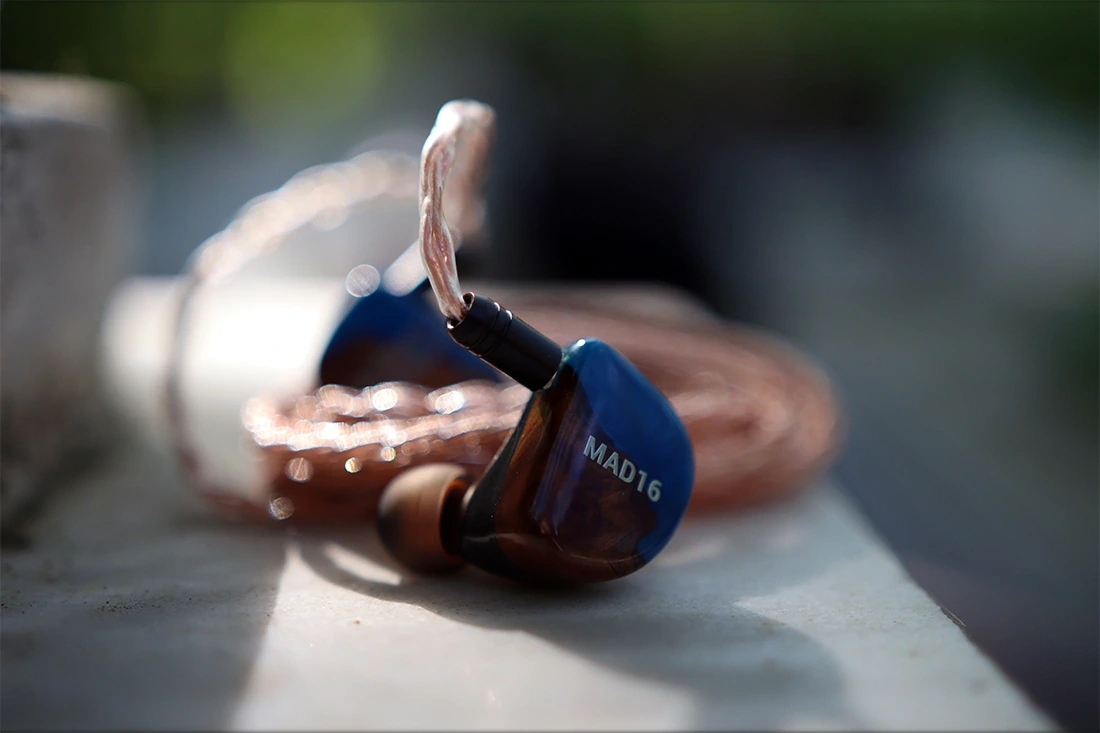
The treble of MAD16 continues the precision and accuracy we’ve seen in the midrange and the bass, and it is also super precise, but with the twist of being slightly relaxed and fatigue-free. No music lover and audiophile wants to avoid detail, and everyone wants to have as much resolution as possible but everyone takes a step back when the sound is fatiguing and dirty instead of detailed and smooth. MAD16 has a clean and sparkly treble that extends as high as about 18 kHz, but the whole treble is presented quieter than the midrange and the bass, just enough for it to stay fatigue-free at all times, but still having enough high end deliver for sound to be balanced and clean, detailed and crisp. You don’t need to go too far to find this, as even songs like The Offspring – Get It Right, which was recorded in a brighter fashion shows this, but the song is still super enjoyable and clean, and you’re more likely to notice how sweet and detailed the guitars are in the song, and how fun it is to listen to it, than it is to enjoy the cymbals as being intrusive. Ambient Acoustics MAD16 can show anyone, regardless of their initial music tastes, that they’ll like what they hear from MAD16, kinda like Pizza, when done well, can satisfy the hunger of virtually anyone.
Comparisons
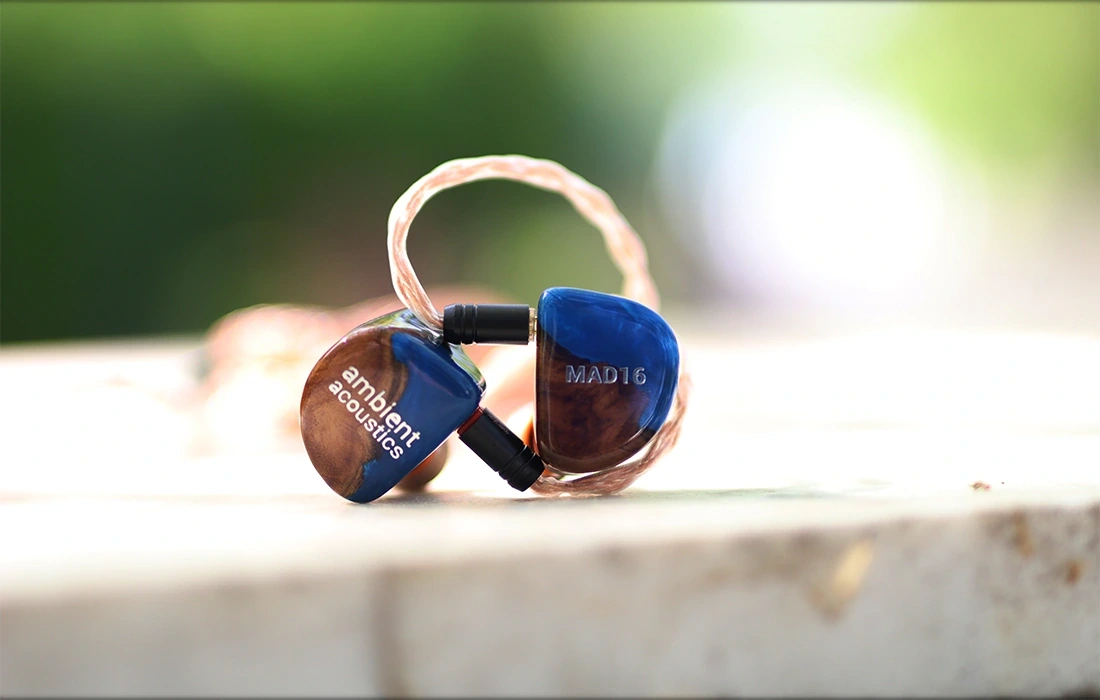
Ambient Acoustics Main Audio Destination MAD16 vs Final Audio A8000 (2500 USD vs 2400 USD) – The overall comfort is better on Final Audio A800, which is smaller, and although it has a more edgy design, the raw difference in size can be felt. Like most comparisons we’ll explore today, the A8000 has detachable cables, but doesn’t have a custom version. The tuning is very different from the get go, with the A8000 being far sharper, brighter, cleaner and more technical in sound than MAD16. You’ll notice this so fast that you’ll know from the start if you want a natural, clean sound as MAD16 has, or if you want a really technical, yet potentially fatiguing sound like the one of A8000 right away. If you want to enjoy something clean and natural, you’ll surely go for MAD16, while A8000 is for those who have a real kink for detail and ready to sacrifice basically every other aspect of sound for the most technically capable sound.
Ambient Acoustics Main Audio Destination MAD16 vs Audeze Euclid (2500 USD vs 1300 USD) – The comfort is better on the Euclid, which is considerably smaller and more ergonomic, but both have detachable cables. The technology is different, with Euclid having Planar magnetic drivers, and creating a very different sonic presentation from MAD16. The sonics are far more natural on MAD16, with Euclid being a much brighter and sharper IEM. This means that Euclid can present certain details better, having a more textured sound, with a lighter sound. MAD16 has a much deeper bass, more impactful overall sound, and a juicier midrange, with a more musical presentation. Here, the trick is that Euclid can be more technical and more analytic than MAD16, but that comes at the cost of bass, which is more natural on MAD16, giving MAD16 a more natural, fuller and less fatiguing sound. You can EQ euclid more than MAD16, as it has more headroom, but when spending over 1000 USD on an IEM I try to not explore EQ options, as you’re likely to want to enjoy it in its default state, hence this comparison.
Ambient Acoustics Main Audio Destination MAD16 vs Lime Ears Aether R (2500 USD vs 1400 USD) – Aether R is an older IEM that I reviewed in the past, but still relevant today. The overall comfort is about equal, both IEMs having equal size and both being on the larger side of things. The overall tuning is different, with Aether R being warmer, thicker and having an upper midrange damping that leads to a blunted cymbal presentation compared to MAD16 that simply has a smoother treble, and a more natural midrange, with a fuller sub bass, without having a colored bass. Aether R is considerably more affordable than MAD16, which is a good reason you’d go for it, but I’m looking forward to what Lime Ears might release soon, as the market keeps getting more and more competitive.
Ambient Acoustics Main Audio Destination MAD16 vs Unique Melody MEST MK2 (2500 USD vs 1500 USD) – We have a similar comfort between the two, and both have detachable cables. The overall drive factor is similar, both are easy to drive, and both are sensitive to hissing, although MAD16 has slightly higher hissing with source. The tuning is actually quite different between MEST MK2 and MAD16, with MEST MK2 having a really specific bass tuning that has a full impact, and a stronger sub bass than the mid bass and the upper bass. MAD16 has a more natural bass, smoother and cleaner bass presentation that provides better coherency between instruments (which is ironic since it has only Balanced Armatures). The midrange is more forward on MAD16, it has better instrument separation, while it is more recessed on MEST MK2. The clarity is similar between MAD16 and MEST MK2, detail is similar too. The treble presentation is smoother, more relaxing but still presenting the same information on MAD16, while MEST MK2 is brighter, much more sparkly and has a much stronger treble presence and brightness. If you’re a fan of more V-Shaped or U-Shaped presentations, you’ll enjoy MESt MK2 more, while if you’re into a natural and clean sound and want utmost precision, MAD16 can offer that.
Ambient Acoustics Main Audio Destination MAD16 vs Fir Audio VxV (2500 USD vs 999 USD) – We have better comfort in VxV, as it is smaller and more comfortable, both IEMS having detachable cables. The overall drive factor is better on VxV, which although slightly harder to drive, has less sensitivity to output impedance and will have less hissing with sources that have high output impedance. The overall tuning is actually quite similar between VxV and MAD16, and at times VxV can sound like a mini MAD16, there are some key differences as well. MAD16 is more neutral and has a cleaner sound, with more juiciness in the midrange, and a slightly stronger treble. VxV is warmer in the midrange, and has a smoother treble, which makes it more relaxing and easier to listen to, but it also has a slightly lower bass quantity and impact, while MAD 16 can show the bass better in most music, especially Punk and Metal, where VxV is more full in general, not having a necessarily stronger sub bass and bass outline. The soundstage is similar, MAD16 having a slightly wider and deeper stage, with better instrument separation, especially in the low end. Of course, when you take into account the price difference, VxV is a really good deal, and it is like a mini MAD16, but if you want an upgrade from VxV with a similar tuning, MAD16 might be the answer to your search.
Ambient Acoustics Main Audio Destination MAD16 vs CTM Clear Tune Monitors Da Vinci IX (2500 USD vs 1800 USD) – The overall comfort is slightly better on Da vinci IX, which has a smaller body and design, and a more ergonomic build for the universal variant. MAD16 is going to be infinitely more comfortable if you go for the custom version. The overall drive factor is similar, and both IEMS are similarly easy to drive, and both are somewhat sensitive to sound, both relying on balanced-armature only designs to stay afloat. The sonic presentation is quite different, with Da Vinci IX focusing on being warm, wide and having a less precise sound, which helps a lot if you’re a fan of warm and smoother tunings, while MAD16 goes for a much more precise sound, more punchy bass, lower bass bloat, and a more natural midrange, with better treble presence and precision. MAD16 is much more detailed and revealing, and would make better competition for Da vinci X, the top of the line from Clear Tune Monitors. The soundstage is slightly larger on Da Vinci IX, but has better instrument separation and precision for MAD16.
Value and Conclusion
While shorter than my review for MAD24, I spent a lot of time with MAD16 to best understand their sound, design, and why you’d want to go with such a pricey IEM. It is no joke, and priced at 2500 USD, MAD16 is one of the most expensive In-Ear Monitors that I tested, but the company designed from the ground the inner chamber and arrangements, and how including 16 Balanced Armatures in each IEM, so you have 16 mini speakers in ears, can work. Also, the resolution, detail and precision of MAD16 is much better than most speakers you can grab around the price point, if you need to do some music work.
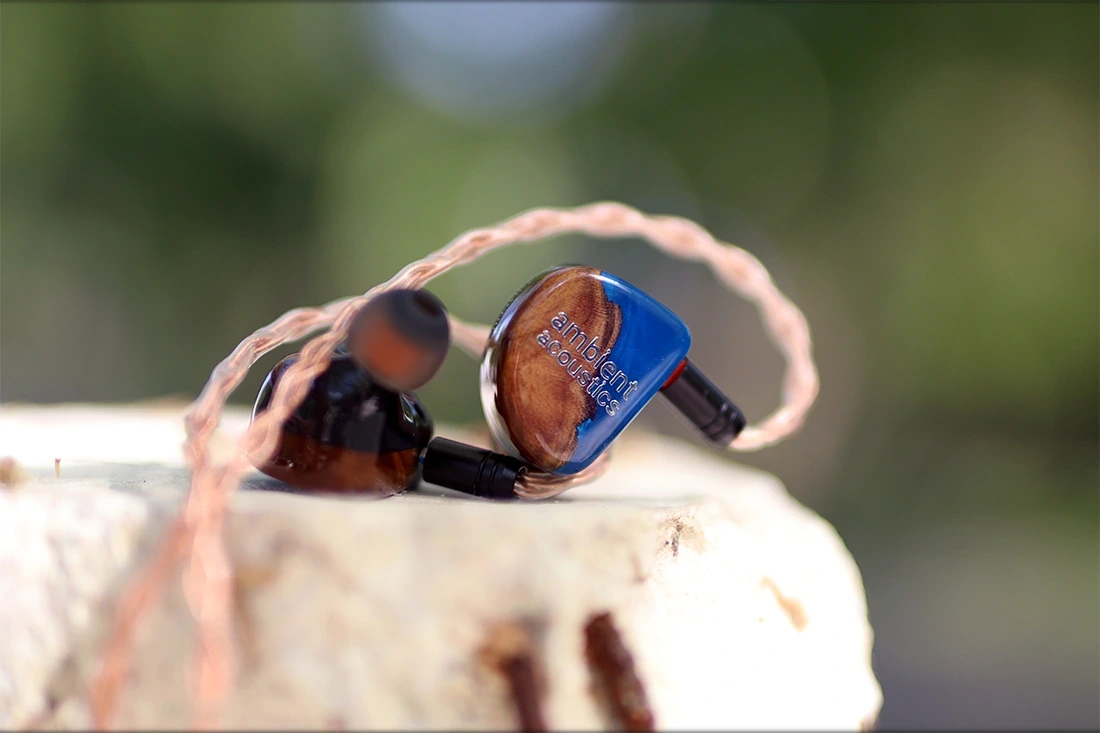
Interesting, though, MAD16 is a more precise IEM than MAD24, making this one the preferred choice for artists, and I’m sure that as soon as Ambient Acoustics gets back to work, they’ll struggle to meet demand on those IEMs. A big part of the value also comes from the fact that MAD16 is a boutique, handmade and fully customizable, the universal variant being more of a rarity, and usually customers get customs, with custom designs and personalization. In fact, MAD16 is so awesome that I’m going to add it to Audiophile-Heaven’s Hall Of Fame for being an outstanding IEM with superb dynamics, clarity and impact.
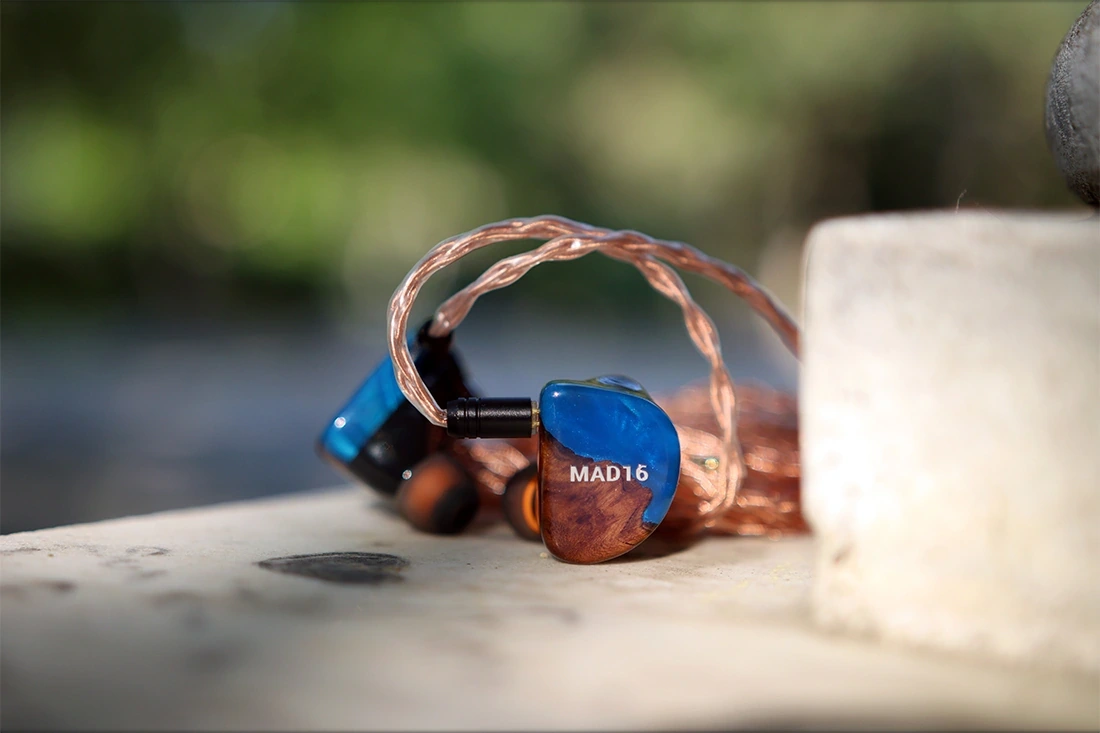
At the end of the day, if you enjoy precision, impact and a clear, well defined sound with super good resolution and detail, and if you appreciate a boutique product, handmade for your ears, you should check out Ambient Acoustics MAD16 and the intriguing performance they provide.
Product Link
You can grab one from www.amazon.com here: https://amzn.to/3ArX7R5
If you’re in the UK, you can grab one from www.amazon.co.uk here: https://amzn.to/3ArRrXg
And if you’re from Europe, you can grab one from www.amazon.de here: https://amzn.to/3PzyHJw
Packaging
Let’s get the packaging out of the way:
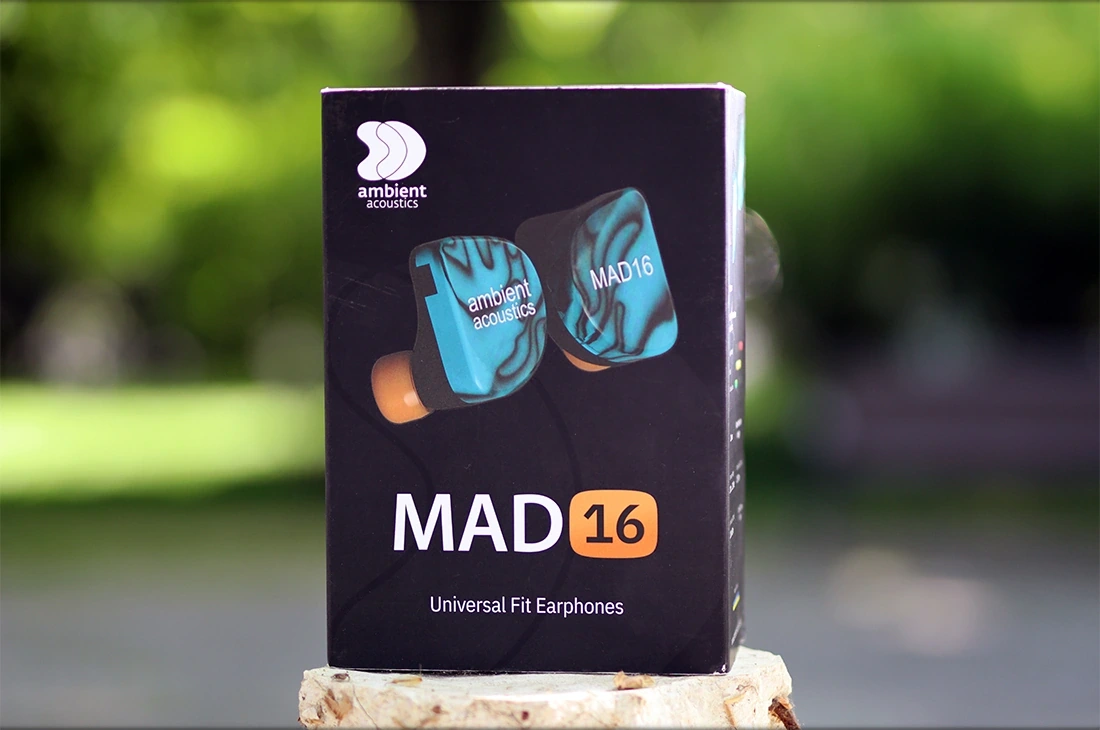
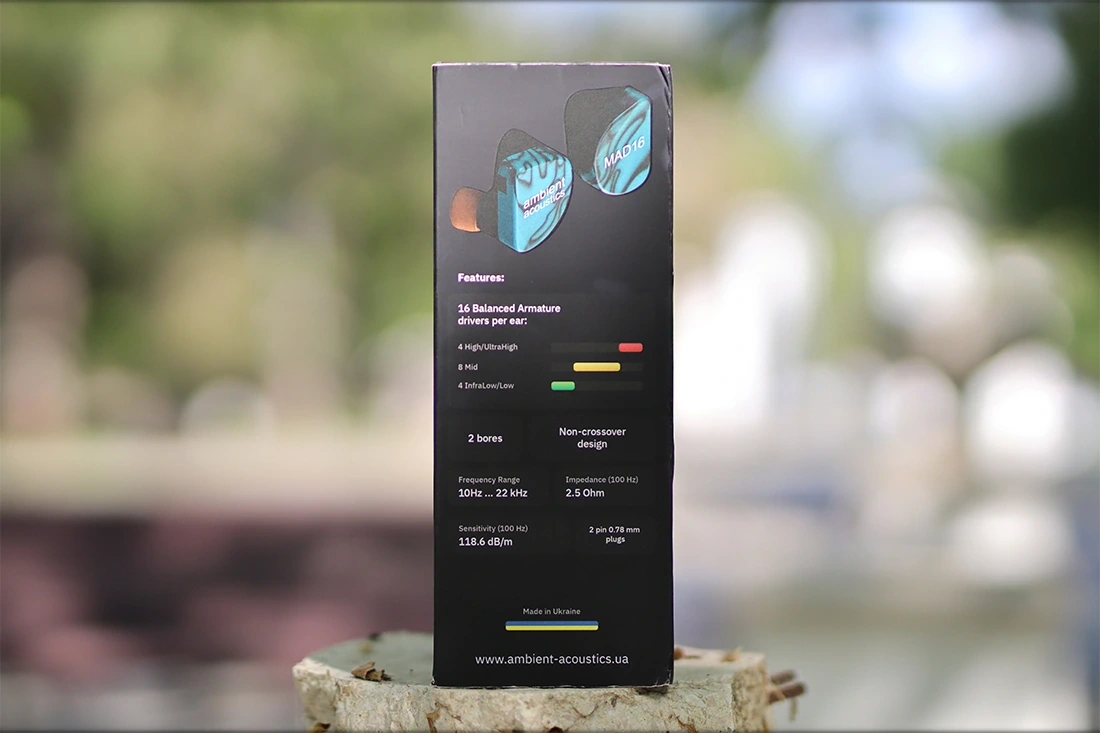
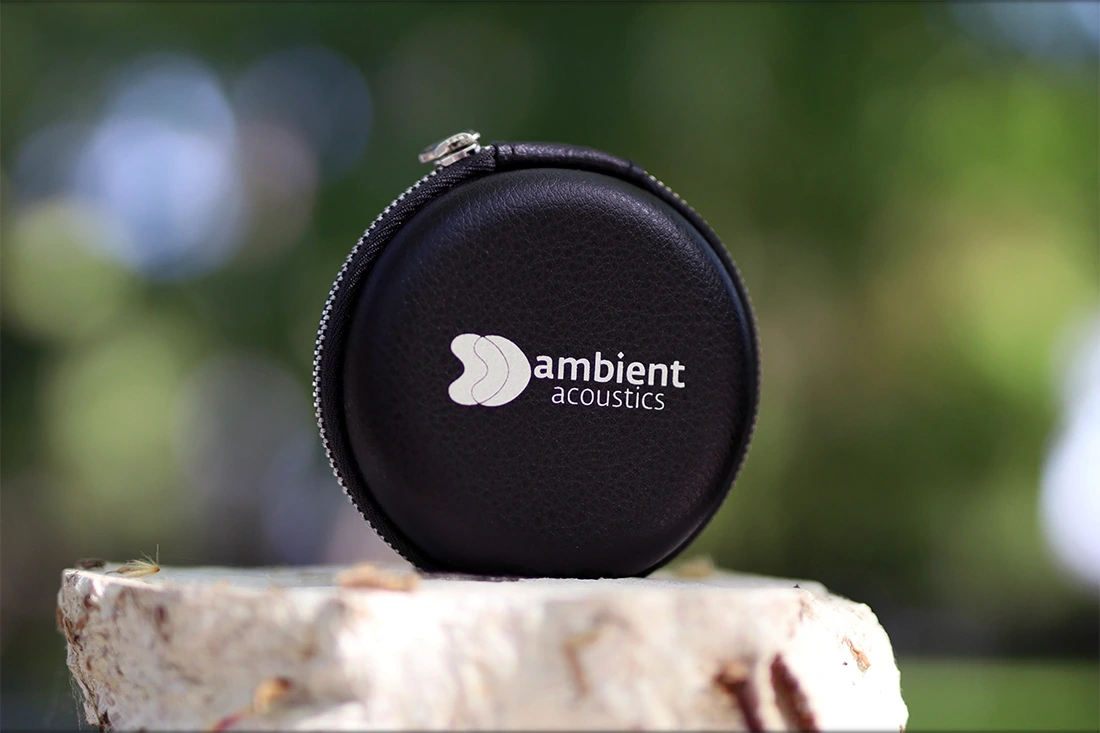
The package of MAD16 is actually uniquely designed, and the usage of an orange logo for MAD16 reminds slightly of another popular website for entertainment, most probably Amazon. Unfortunately, Ambient Acoustics has to make those by hand, and they aren’t yet available on Amazon, at the moment the company being unable to produce new IEMs, although hopefully they’ll be back in business. Included with MAD 16, we have:
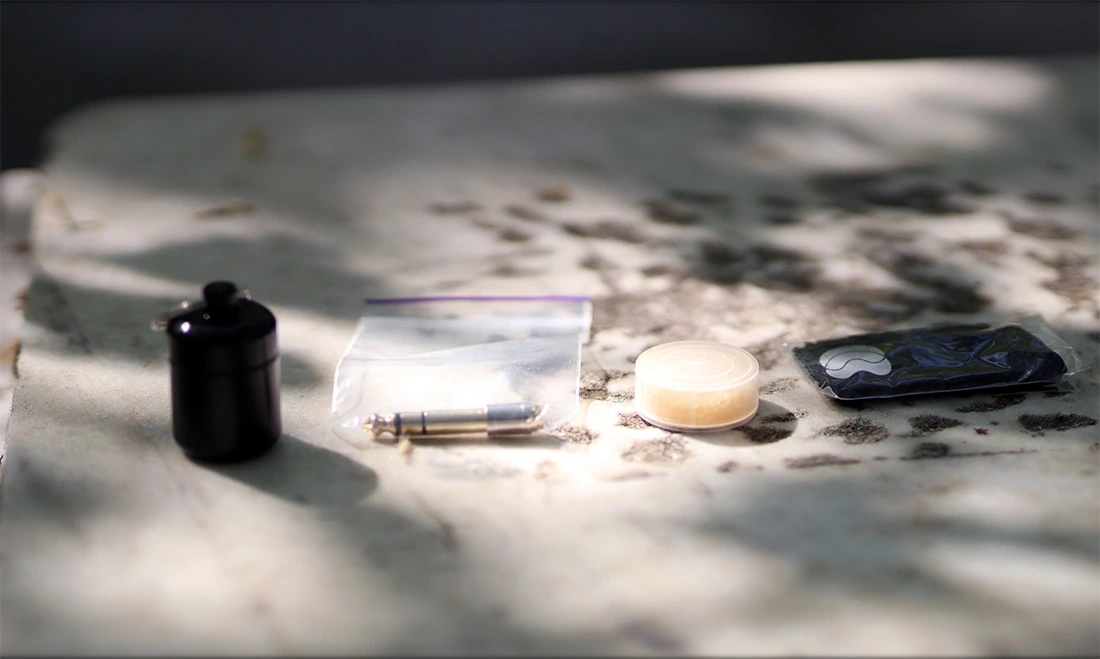
- Main Audio Destination MAD 16 IEMs
- 1.2 meters, 3.5mm Single Ended Cable
- Genuine Leather Case
- Silicone Tips – 3 Pairs
- Cleaning Cloth
- Special case for the tips
- Silica bag for keeping the IEMs dry
- 3.5 to 6.3mm adapter
--- Please remember to stay safe, and always have fun while listening to music!---
- If you have a dime to spare, please donate, and help us! It would make the day brighter for me and my wife-
Full Playlist used for this review
We listened to more songs than those named in this playlist, but those are excellent for identifying a sonic signature. I recommend trying most of the songs from this playlist, especially if you’re searching for new music! The playlists are different for Spotify, Tidal and Youtube, and based on the songs I enjoy and are available on each!
https://www.youtube.com/playlist?list=PL_cjBXGmwSHSdGcwuc_bKbBDGHL4QvYBu
https://open.spotify.com/playlist/5J3oloz8Riy9LxEGenOjQ0?si=979ba4f082414be7
https://tidal.com/browse/playlist/330fd544-8e5b-4839-bd35-676b2edbb3d5
--- Contact Us ---






[…] The overall signature of UA5 can be described as rather intimate, impactful, detailed, precise and slightly warm in tuning. UA5 is the kind of DAC AMP you want to pair with most entry-level IEMs and headphones, especially those pesky Chifi options with high amounts of treble and which can sound pretty bright and fatiguing. In fact, Ua5 is one of the most pleasing sounding dongle DAC AMPs, with a super nice bass, a smooth midrange, and a smoother treble that’s never aggressive or fatiguing. I mainly used the Apodizing filter as it seems to make music the most pleasing, with less amount of peaks and harshness. To test it, I used a multitude of headphones including ibasso SR-2, Audeze MM-500, Westone MACH 60, Westone MACH 40, FiR Audio NE4, HIFIMAN HE1000 V2, Periodic Audio Titanium, and Ambient Acoustics MAD16. […]
[…] the super ergonomic design. They will be compared to other high-end and flagship IEMs, including Ambient Acoustics MAD16 (2500 USD), Oriveti OV800 (999 USD), Unique Melody MEXT (1200 USD), Fir Audio VxV (999 USD), and […]
I ordered a pair after reading your review, thanks a lot for all the effort you put in those reviews!